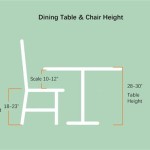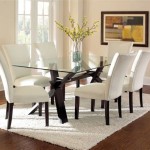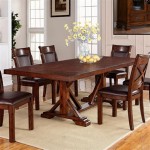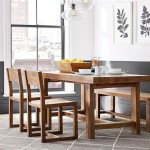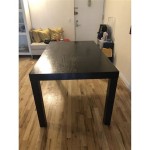Understanding Dimensions: Dining Tables for 10
Selecting a dining table for ten individuals involves careful consideration of dimensions to ensure comfortable seating, sufficient space for serving dishes, and harmonious integration with the overall dining room environment. The optimal dimensions are not fixed but depend on various factors, including the shape of the table, the chair size, and the available floor space.
This article will explore the critical dimensions to consider when choosing a dining table designed to accommodate ten people. It will delve into relevant measurements, different table shapes, and considerations for maximizing usability and aesthetics. The goal is to provide a comprehensive guide for making informed decisions when selecting a dining table for this specific capacity.
Key Dimensions: Length, Width, and Height
The length and width of a dining table directly influence the seating capacity and the available space for place settings and serving dishes. The height, while seemingly less crucial, significantly impacts comfort and ergonomics. Focusing on these three dimensions is paramount in choosing a suitable table for ten.
Length: For a rectangular dining table designed to seat ten, a minimum length of 96 inches (8 feet) is generally recommended. However, a length of 108 inches (9 feet) to 120 inches (10 feet) is preferable for greater comfort and more room between diners. The increased length allows for more generous place settings and easier passing of dishes.
Width: The width of the table should be at least 42 inches. This allows for adequate space for place settings on both sides of the table and sufficient room for a centerpiece or serving dishes in the middle. A width of 48 inches or greater is often preferred, especially if serving multiple dishes simultaneously.
Height: The standard dining table height is between 28 and 30 inches. This height is generally considered comfortable for most individuals and aligns well with standard chair heights. When selecting a dining table, ensure that the chair height allows for adequate legroom beneath the table. A clearance of at least 12 inches between the seat and the table apron is typically recommended.
Shape Matters: Rectangular, Oval, and Round Tables
The shape of the dining table influences the optimal dimensions required to comfortably seat ten people. Rectangular, oval, and round tables have distinct advantages and disadvantages concerning space utilization and seating arrangements. Each shape requires a different approach to dimensioning for a ten-person capacity.
Rectangular Tables: Rectangular tables are a common and versatile choice. As mentioned previously, a length of 96-120 inches and a width of 42-48 inches are typical. Rectangular tables are well-suited for long, narrow dining rooms and provide a defined sense of formality. The linear shape facilitates conversation across the table but can make it more challenging to interact with those at the far end.
Oval Tables: Oval tables offer a softer aesthetic compared to rectangular tables while maintaining a similar seating capacity and footprint. The rounded ends allow for easier passage around the table and eliminate sharp corners. For a ten-person oval table, the dimensions should be similar to a rectangular table of comparable capacity, typically 96-120 inches in length and 42-48 inches in width. The oval shape can promote a more inclusive and conversational dining experience.
Round Tables: Round tables foster a sense of intimacy and encourage conversation among all diners. However, accommodating ten people at a round table requires a significant diameter. A round table designed for ten should have a diameter of at least 60 inches, but preferably 72 inches or greater. This allows adequate space for place settings and comfortable seating. Smaller diameters may feel cramped and restrict movement. Round tables are best suited for square or larger dining rooms, as they can occupy a substantial amount of floor space.
Beyond Dimensions: Considerations for Comfort and Aesthetics
While dimensions are fundamental, other factors contribute to the overall comfort and aesthetic appeal of a dining table. These considerations include leg placement, chair style, material selection, and the overall style of the dining room. Ignoring these aspects can lead to a less-than-ideal dining experience, even if the dimensions are technically correct.
Leg Placement: The placement of the table legs is crucial for maximizing legroom and ensuring comfortable seating. Legs positioned too close to the corners can restrict movement and make it difficult for diners to sit comfortably. Consider tables with pedestal bases or legs that are set back from the edge of the table to provide ample legroom for all ten diners. Cantilevered designs can also be effective in maximizing space.
Chair Style: The style and size of the chairs should complement the dimensions of the table. Chairs that are too wide or bulky can overcrowd the table and make it difficult for diners to move around. Conversely, chairs that are too small may feel out of proportion to the table. Measure the width of the chairs and ensure that there is sufficient space between each chair for comfortable seating and movement. Armchairs, while often more comfortable, typically require more space than armless chairs.
Material Selection: The material of the dining table significantly impacts its durability, aesthetic appeal, and ease of maintenance. Solid wood tables offer a classic and durable option, while veneer tables provide a more cost-effective alternative. Glass-top tables create a modern and airy feel but may require more frequent cleaning. Consider the overall style of the dining room and choose a material that complements the existing décor. The finish of the table should also be durable and resistant to scratches and stains.
Dining Room Space: Always consider the size and layout of the dining room when selecting a dining table. A large table may overwhelm a small room, while a small table may look lost in a large space. Measure the dimensions of the dining room and create a floor plan to visualize how the table will fit within the space. Allow at least 36 inches of clearance between the table and the walls or other furniture to ensure comfortable movement around the table. This clearance should ideally be 42-48 inches for high-traffic areas.
Selecting the right dining table for ten requires careful planning and attention to detail. By understanding the key dimensions, considering the shape of the table, and paying attention to other factors such as leg placement, chair style, and material selection, one can create a comfortable and aesthetically pleasing dining space that is perfectly suited for gatherings of family and friends.

How Do I Choose The Right Size Of Solid Wood Dining Table Set For My S Picket Rail Custom Sofas Furniture

Table Dimensions

Large Round Dining Tables Seats 10 Foter

Useful Standard Dimensions For Home Furniture Engineering Discoveries

10 Seater Solus Extendable Outdoor Dining Set Temple Webster

Dining Table Size Guide 4 To 10 Seat Dimensions Shapes

Size Of 10 Person Table Standard Dining

Mahmayi Modern Wooden Dining Table 360cm X 100cm 75cm Dimension 10 Seater Loop Leg Up To 180kg Weight Capacity Space Efficiency Anthracit

Dining Table Size And Seating Guide

71 95 Extendable Modern Minimalist Dining Table For 6 10wishwhite Glossy Sintered Stone Classic Four Legs

